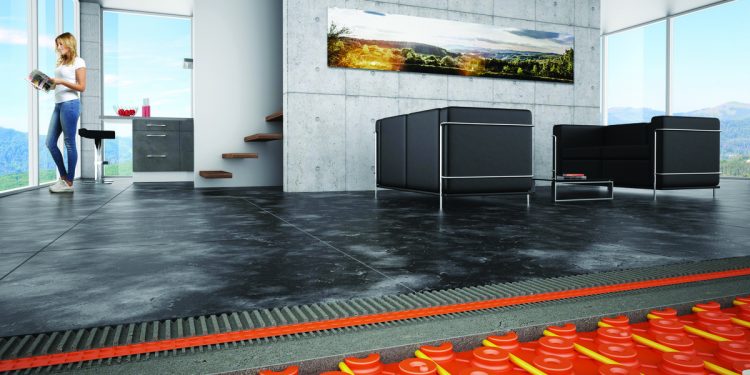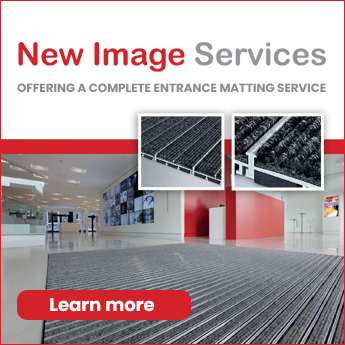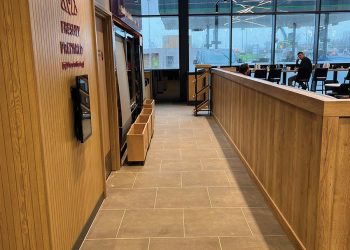Focus on a low-carbon future and improved energy efficiency is leading to an ever-increasing demand for underfloor heating systems. Considered in tandem with the positive impact that use of these systems has on the design of rooms, these features make for a solution that is all the more appealing in the eyes of the conscientious specifier.
Tile and stone are great partners to underfloor heating, due to their high thermal conductivity and good heat retention credentials—these properties make for a quick warm-up and more efficient use of energy. But a heated floor assembly also requires appropriate protection in order for the covering to remain intact—the specifier must remember that the differentials of movement between the substrate and surface covering will be magnified in a heated floor assembly due to the greater range of temperatures that it is subjected to. Therefore, this type of assembly is more vulnerable to failure.
There are now systems available with the in-built capacity to protect an assembly against the effects of expansion and contraction, as well as dramatically reduce the height build-ups and curing times required. Schlüter-Systems offer electric and hydronic (wet) systems that make the most of modern technology, to the benefit of parties across the construction chain.
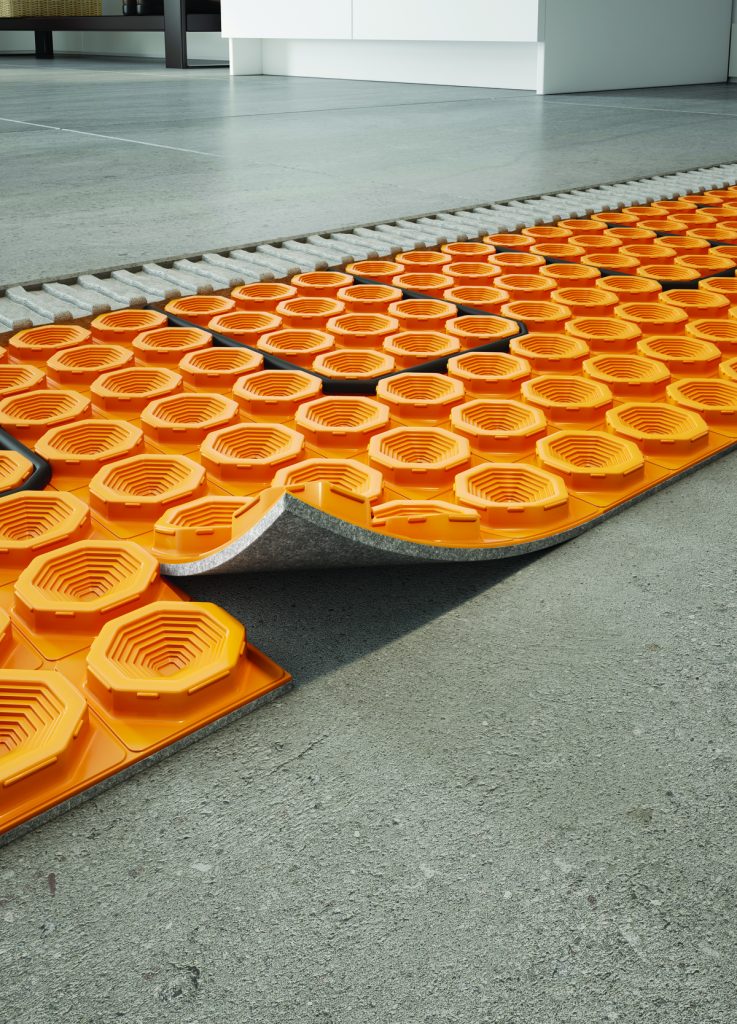
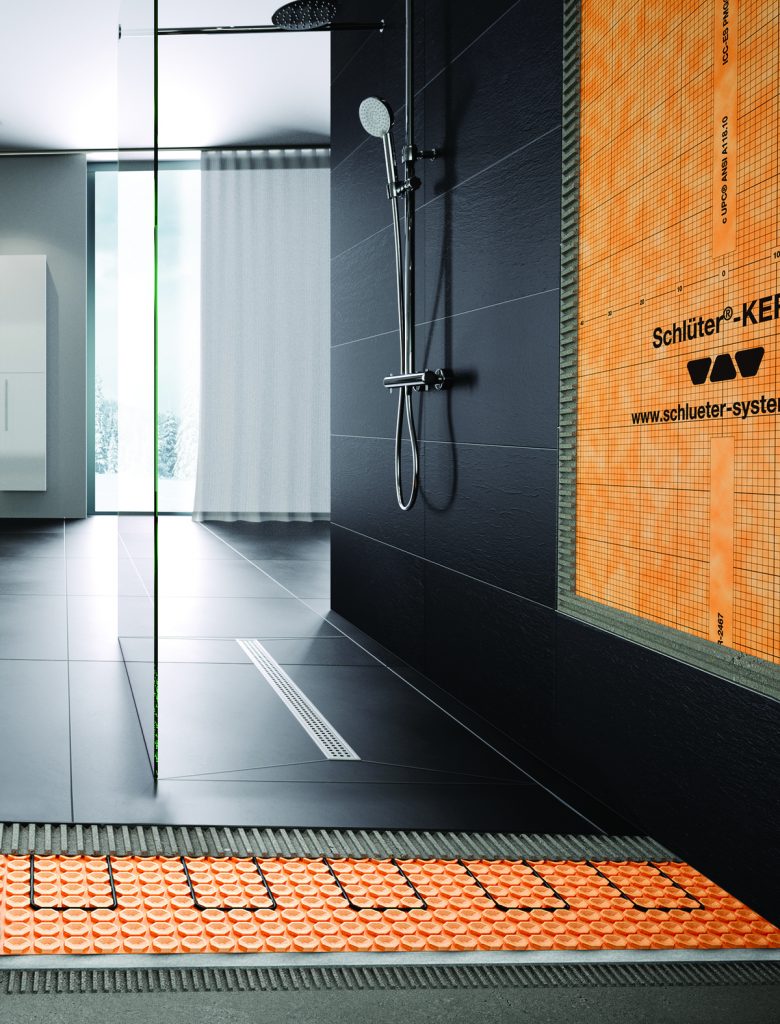
Why use electric?
The main advantages that electric systems offer are:
Suitability for retrofit
Installation of an electric system is relatively simple and can be performed alongside a routine flooring renovation whereas hydronic systems that can be retrofitted and are suitable for tile are a lot more difficult to find and the process of installation is more complex.
Zonal heating provision
Where electric systems really come into their own is in the provision of concentrated zonal heating. They are a great choice for infusing additional luxury into particular areas of a project and enhancing the routines of building occupants.
Examples of this include:
- Use within bathrooms and wetrooms, to make early morning preparations more pleasant and dry out residual moisture
- Use around popular communal standing areas in a home such as surrounding kitchen islands
- Use in the creation of heated features such as benches, shelves and walls
Heat on demand
Electric systems are extremely responsive, taking a short amount of time to heat up due to their proximity to the surface. The exact amount of time taken will vary slightly—dependent on watts per sqm, tile thickness and insulation or the incorporation of a thermal break—but they can essentially provide heat on demand.
All electric systems are not created equal
In the selection of an underfloor heating solution, deciding on the type of system is only half the battle; the specifier’s next job is to wade through the ever-increasing pool of options available from manufacturers.
A quick web search will give you an indication of the most common format for electric underfloor heating systems: many consist of a roll-out mesh matting with a cable that is taped in place. These mesh systems can be self-adhesive, taped or stuck down via use of a separate adhesive and vary markedly in cost and quality. The predominance of these systems could trick you into believing that they are the only option for electric underfloor heating. However, there is another way – one that can save you time, build-up and hassle.
Mesh vs. membrane
Electric underfloor heating systems based on an uncoupling membrane first appeared in 2013, with the launch of the innovative Schlüter-DITRA-HEAT-E. These integrated systems offer an enticing alternative to their mesh-based cousins, not least because of their multi-functional nature. In short, they offer a solution that simultaneously heats and protects an installation.
Hassle-free electric underfloor heating
The award winning Schlüter-DITRA-HEAT-E system makes the installation of electric underfloor heating simpler and easier than ever before. The system’s heating cables are designed to clip securely into its studded uncoupling mat, saving installation steps and height, and ensuring even spacing and therefore a consistent heating experience. In addition, its low assembly height makes it ideally suited for most environments and it can be installed over the majority of substrates.
Schlüter-DITRA-HEAT-E offers optimum freedom for creating heating zones exactly where they’re needed and can also be used for walls, opening up a whole new world of possibilities for the creation of heated features.
Peel & Stick membrane
Following on from the success of Schlüter-DITRA-HEAT, a new Peel & Stick variant has been added to the range. Featuring the same key benefits as DITRA-HEAT, the Peel & Stick version has a self-adhesive anchoring fleece laminated to the underside, which means no tile adhesive is required underneath the mat. This makes the installation especially easy and saves significant amounts of material and time.
Crack-free installations with uncoupling properties and movement joints
All materials expand and contract with temperature changes, with tile and stone doing so at a different rate to the substrate upon which they are installed. Direct adhesion of the tile or stone covering to the substrate means that the two layers will be rigidly bound together, meaning movement and stress cracks in the substrate will transfer through to and damage the layer above.
This phenomenon can be prevented with movement joints and uncoupling membranes, the combination of which relieves stresses and allows for movement. With many electric underfloor heating systems, an uncoupling membrane would have to be installed as an additional layer, but the matting of Schlüter-DITRA-HEAT-E provides the necessary uncoupling capability as well as a host of other features.
Schlüter-DITRA-HEAT is part of the Schlüter-DITRA family of mattings that feature uncoupling, crack-bridging, vapour management, load distribution, waterproofing and sound-reduction properties. Together, these features relieve stresses that occur between the substrate and covering to manage movement and prevent cracking and debonding of the covering.
In larger tiled areas, installing the appropriate movement joints in line with those recommendations, will prevent tiles from cracking, bulging and debonding. And by ‘appropriate,’ that means one which can do what is being asked of it.
There are different widths of pre-formed movement joints, and the correct width and material – aluminium, stainless steel or PVC – must be specified to take thermal movement into account.
The amount of movement that can be absorbed – and therefore the degree of protection given by the joint – depends on the size of the profile and the compressible material used. Pre-formed surface joints will usually accommodate movement up to 20% of the movement zone width.
A 10mm joint will extend and compress by approximately 2mm. One of Schlüter’s stress relieving movement joints, the Schlüter-DILEX-KS, has a movement zone of 11mm, and will accommodate up to 2.5mm of tile movement. Because there are specific movement joints for specific types of application, most tiling failures are caused by using joints that aren’t suitable for what is being demanded of them. There are many situations, each with their own technically engineered solution in the form of the correct joint.
Thermal breaking and impact sound reduction
The Schlüter-DITRA-HEAT-E system can also be specified with the advanced Schlüter-DITRA-HEAT-DUO matting, which boasts the additional features of an integrated thermal break and impact sound reduction of up to 13dB.
These two additional features are achieved thanks to a unique 2mm fleece layer on the underside of the uncoupling membrane, which allows 80% of the heat to rise to the surface during the heat-up phase for up to 70% faster response time, as well as reducing impact sound by a perceived 50%.
A thermal break is an element within an assembly which reduces the flow of thermal energy between conductive materials. The thermal break in Schlüter-DITRA-HEAT-DUO ensures the heat doesn’t get lost but is instead transferred directly to the floor covering above.
This combination of fleece and matting allows an input of 136 W/sqm, to push up to 110 W/sqm to the surface, reacting faster than 200 W/sqm systems and making Schlüter-DITRA-HEAT-E-DUO cost less to run compared to other systems, which can lose 50% of their heat into the subfloor below.
Reducing layers and height within a heated floor assembly
As the system incorporates both uncoupling and underfloor heating, fewer layers are required in the flooring assembly—a traditional system can require numerous products, including insulation board, underfloor heating mat, uncoupling membrane, and encapsulation layers; all of which add height to an installation. By contrast, the whole Schlüter-DITRA-HEAT-E-DUO system comes in at only 7.5mm in height, making it suitable for both new-build and renovation projects and saving considerable build-up within a heated flooring assembly. Where an even lower height is needed, the Schlüter-DITRA-HEAT-E range can offer solutions starting from just 5.5mm.
Bonded waterproofing
In addition to offering all the aforementioned benefits, the Schlüter-DITRA-HEAT-E system can function as a bonded waterproofing assembly, simply by sealing the matting joints with Schlüter-KERDI-KEBA sealing band and Schlüter-KERDI-COLL sealing adhesive.
A variety of control options
Specifiers can choose from a variety of thermostats for the Schlüter-DITRA-HEAT-E system, from a basic analogue stat through to an all-in-one smart thermostat with WiFi and voice control technology. Schlüter’s discreet 2” display smart thermostat can be operated using the touch screen display, remotely via WiFi or by voice control using an Amazon Alexa or Google Assistant smart home device.
Use for under-wall heating
Under-wall heating not only offers bonded waterproofing for walls and a great source of heat, but it is also a safer alternative to a towel rail or radiator, particularly for children and the elderly. Under-wall heating from Schlüter-Systems is a unique solution that is very easy to install and allows radiated heating underneath the tile or stone covering, thus keeping the system protected and away from harm.
Naturally, the use of Schlüter-DITRA-HEAT-E is not limited to kitchens and bathrooms; floor and wall heating enhances living, dining and working spaces too.
Why use hydronic?
An alternative to installing an electric system is to use a wet (or hydronic) system to provide an in-screed heating solution. The main advantages of a hydronic system are:
Cheaper to run, therefore more suited for larger areas
Although hydronic systems are more costly initially, they are cheaper to run in the long-term. Therefore, they are ideal for large-scale coverage, and you will often see them used across the entirety of a ground floor.
Designed as a primary heat source
Hydronic systems are designed to heat the air within the room as well as the surface covering. They can therefore replace radiators, connecting directly to a boiler and act as the primary heat source for a room.
Can be run using eco-friendly fuel sources
As well as being connected to an existing boiler, hydronic systems can be powered by several different renewable energy sources, including ground source heat pumps.
Environmentally friendly hydronic heating system
The Schlüter-BEKOTEC-THERM underfloor heating system takes an integrated approach to the installation of underfloor heating, providing solutions to many of the problems associated with traditional underfloor heating installations.
The system offers many advantages to both the specifier and installer, including removing the need for screed movement joints, which allows for more control over the design of the surface covering. The considerably lower installation height of the Schlüter-BEKOTEC-THERM underfloor heating system, coupled with the unique design of the Schlüter-BEKOTEC modular screed panel, means less screed is needed—making it easier, quicker, and cheaper to install and run. Less screed also means a reduced environmental impact both in terms of producing the amount of screed needed for the system (only 8mm over the system studs compared to the 65-75mm needed over traditional systems) and in terms of heating this reduced mass of screed.
Rapid response and an even heating experience
Less screed means the heating pipes are located closer to the surface. As a result, the underfloor heating system can be run at considerably lower temperatures and still achieve the same heating results. A low supply temperature of approximately 30°C, compared to between 50-55°C in some traditional systems, means Schlüter-BEKOTEC-THERM is also extremely effective both with conventional heat generation devices and regenerative energy sources. The ability to run at lower temperatures makes the Schlüter-BEKOTEC-THERM underfloor heating system suitable for use with heat pumps, as well as other environmentally friendly energy sources that work more efficiently at lower temperatures, making it a green choice with economical, energy saving properties.
The modular screed panels of the system are designed to hold the heating pipes in place at regular and exacting intervals, resulting in a more even heating experience than you would get with either radiators or traditional underfloor heating systems.
The Schlüter-BEKOTEC-THERM system also features a range of control modules and room sensors, adding flexibility and convenience to the regulation of room temperature. The core of the system can be connected to a timer module for energy-saving temperature reduction and the connection modules for wired or wireless room sensors can be freely combined with the base module, which enables the flexible expansion of existing systems at any time. Modern wireless and wired room sensors allow for individual room temperature control to suit requirements. The Schlüter-BEKOTEC-THERM system can also be integrated with Building Management Systems (BMS).
Construction and time-saving benefits
Since a thinner screed requires much less material, the final Schlüter-BEKOTEC-THERM assembly is lighter than traditional screed installations and saves considerable construction time. Vitally, no commissioning of the system is required before tiles are installed; dependent upon the system and screed used, the commissioning process can take up to several weeks, so time savings in this area are greatly appreciated on-site.
Schlüter-BEKOTEC-THERM can be easily integrated into an existing heating system to provide underfloor heating for some rooms and radiators for others but can also be used cost-effectively across an entire building. Another major advantage is that it can also be used to cool the floor down in the summer, either via passive cooling of the unheated water or by pumping water chilled to around 18-19°C through the pipes.
In addition to tile and stone, the Schlüter-BEKOTEC-THERM system can be used with other coverings including timber, carpet, vinyl and parquet, to name but a few.
Approved installations for peace of mind
Schlüter-BEKOTEC-THERM has a covering and assembly warranty, which can be extended if the system is installed by a member of the Schlüter Approved Installer Network (SAIN).
SAIN members have completed full training with Schlüter. The network not only gives accreditation to the individual, but also to the company as a certified organisation. This provides reassurance to you, as the specifier or architect, that the system will be installed to the manufacturer’s standards and best practice, and minimises installation risks—ensuring a robust, reliable installation.
Learn more about specifying underfloor heating
The CPD seminar ‘Specifying Integrated Underfloor Heating Systems’ covers the key considerations in the specification of a modular underfloor heating system that helps to protect tile and natural stone floor coverings from cracking, splitting, tenting and debonding, and explores the theory behind modular screed systems. Enhance and reaffirm your knowledge with this 45 – 60 minute presentation, held at your offices or online.
For support across all elements of your specification journey – from learning about the fundamentals of tiling systems, through to project-specific advice and detailing – call 01530 813396 or email specifiers@schluter.co.uk.
Schlüter-Systems Ltd’s specification website is a helpful companion for architects and specifiers tasked with achieving first-class installations of tile and stone; head to www.schluterspecifier.co.uk, where you can also request a VR headset to engage with the company’s 360 Tour of their impressive and educational premises.
Schluter-Systems Ltd
T. 01530 813396
E. specification@schluter.co.uk
W. www.schluterspecifier.co.uk



